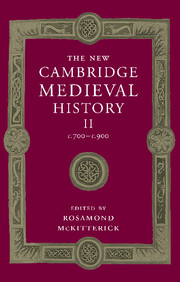Book contents
- Frontmatter
- PART I POLITICAL DEVELOPMENT
- PART II GOVERNMENT AND INSTITUTIONS
- 15 Kingship and royal government
- 16 The aristocracy
- 17 Social and military institutions
- 18 Economic Organisation
- 19 Rural society in Carolingian Europe
- 20 Money and coinage
- PART III CHURCH AND SOCIETY
- PART IV CULTURE AND INTELLECTUAL DEVELOPMENTS
- Conclusion
- Appendix genealogical tables
- List of primary sources
- Bibliography of secondary works arranged by chapter
- Index of manuscripts
- General index
- Frontispiece">
- Plate section
- Map 4 Charlemagne’s Europe and Byzantium, 814
- Map 19 The ecclesiastical provinces of western Europe 700-900
- Map 20 Carolingian schools, scriptoria and literary centres
- Genealogical table X: Wessex
- References
17 - Social and military institutions
from PART II - GOVERNMENT AND INSTITUTIONS
Published online by Cambridge University Press: 28 March 2008
- Frontmatter
- PART I POLITICAL DEVELOPMENT
- PART II GOVERNMENT AND INSTITUTIONS
- 15 Kingship and royal government
- 16 The aristocracy
- 17 Social and military institutions
- 18 Economic Organisation
- 19 Rural society in Carolingian Europe
- 20 Money and coinage
- PART III CHURCH AND SOCIETY
- PART IV CULTURE AND INTELLECTUAL DEVELOPMENTS
- Conclusion
- Appendix genealogical tables
- List of primary sources
- Bibliography of secondary works arranged by chapter
- Index of manuscripts
- General index
- Frontispiece">
- Plate section
- Map 4 Charlemagne’s Europe and Byzantium, 814
- Map 19 The ecclesiastical provinces of western Europe 700-900
- Map 20 Carolingian schools, scriptoria and literary centres
- Genealogical table X: Wessex
- References
Summary
introduction
social history deals mainly with two topics: (1) social order, concerning the structure of a (former) society and the criteria for its subdivision, and (2) social bonds, informing us about the organisation of social groups and the mechanisms which regulate social life. The individual is always part of several, overlapping communities, from household and family, the village community, the community of serfs on estates, the parish congregation, or voluntary associations, to political orders, like tribes, peoples or nations. The integration of individuals into communities and their dependence on social bonds in the early middle ages can hardly be overestimated.
Before venturing to describe the little we know of early medieval society, it is wise to remember the problems of such an undertaking. These result mainly from a deep discrepancy between the evidence of our sources on the one hand and modern fields of interest on the other. Whereas modern historiography lays a distinct emphasis on social developments, writers of the early middle ages had not the slightest interest in social phenomena as we conceive of them. This means that the evidence is widely dispersed and is to be found in completely different contexts, in a distinct phraseology and under diverse aspects. Social structures, which alter slowly, were not perceived by early medieval authors and often were not even perceivable. Those medieval social ‘theories’ that are known to have existed are inappropriate to satisfy modern needs, whereas the social criteria of modern historians are widely influenced by sociological theories whose application to pre-industrial times still has to be proved valid (which one should not expect to be too successful concerning the middle ages).
Keywords
- Type
- Chapter
- Information
- The New Cambridge Medieval History , pp. 451 - 480Publisher: Cambridge University PressPrint publication year: 1995
References
- 2
- Cited by

